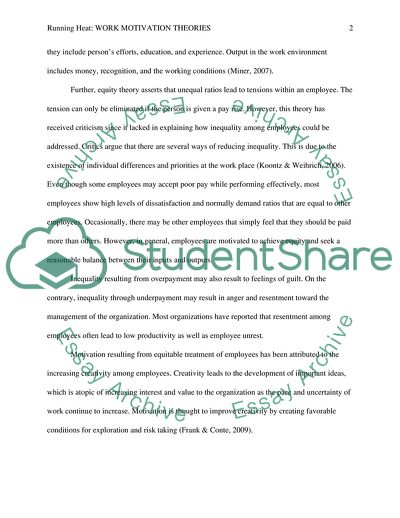Cite this document
(Work Motivation Theories Coursework Example | Topics and Well Written Essays - 3000 words, n.d.)
Work Motivation Theories Coursework Example | Topics and Well Written Essays - 3000 words. https://studentshare.org/psychology/1775048-work-motivation-is-described-as-the-driving-force-behind-action-latham-and-pinder-2005-described-work-motivation-as-being-a-psychological-process-where-individual-and-environmental-factors-intersect-early-theories-of-work-motivation-included-metapho
Work Motivation Theories Coursework Example | Topics and Well Written Essays - 3000 words. https://studentshare.org/psychology/1775048-work-motivation-is-described-as-the-driving-force-behind-action-latham-and-pinder-2005-described-work-motivation-as-being-a-psychological-process-where-individual-and-environmental-factors-intersect-early-theories-of-work-motivation-included-metapho
(Work Motivation Theories Coursework Example | Topics and Well Written Essays - 3000 Words)
Work Motivation Theories Coursework Example | Topics and Well Written Essays - 3000 Words. https://studentshare.org/psychology/1775048-work-motivation-is-described-as-the-driving-force-behind-action-latham-and-pinder-2005-described-work-motivation-as-being-a-psychological-process-where-individual-and-environmental-factors-intersect-early-theories-of-work-motivation-included-metapho.
Work Motivation Theories Coursework Example | Topics and Well Written Essays - 3000 Words. https://studentshare.org/psychology/1775048-work-motivation-is-described-as-the-driving-force-behind-action-latham-and-pinder-2005-described-work-motivation-as-being-a-psychological-process-where-individual-and-environmental-factors-intersect-early-theories-of-work-motivation-included-metapho.
“Work Motivation Theories Coursework Example | Topics and Well Written Essays - 3000 Words”. https://studentshare.org/psychology/1775048-work-motivation-is-described-as-the-driving-force-behind-action-latham-and-pinder-2005-described-work-motivation-as-being-a-psychological-process-where-individual-and-environmental-factors-intersect-early-theories-of-work-motivation-included-metapho.


